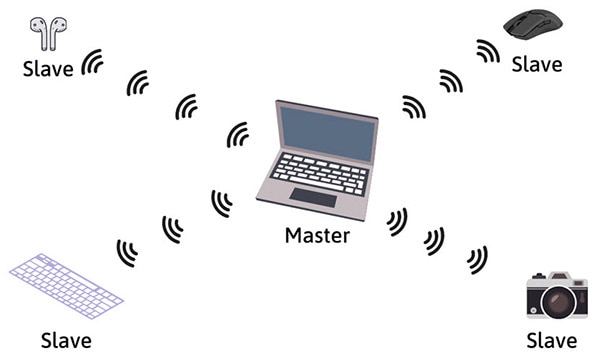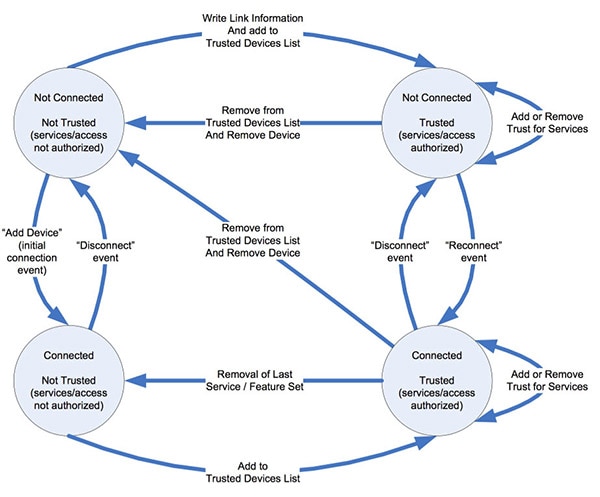Unveiling the Wonders of Bluetooth Technology
2024-04-03 | By DWARAKAN RAMANATHAN
Introduction:
Bluetooth technology is a wireless communication standard that enables short-range communication between devices. It was developed to facilitate communication and data transfer between devices, such as smartphones, tablets, laptops, headphones, speakers, printers, and other electronic gadgets. Bluetooth operates on the 2.4 GHz frequency band and uses a technique called frequency-hopping spread spectrum to avoid interference from other wireless devices operating in the same frequency range.
Key-Features:
- Short-Range Communication:
- Definition: Bluetooth is designed for short-distance communication, typically within a range of about 10 meters (30 feet). Bluetooth devices use radio waves to establish connections, allowing for communication between devices in close proximity.
- Use Cases: This short-range communication is well-suited for scenarios where devices need to exchange data without physical cables, such as connecting a smartphone to a wireless speaker or pairing a headset with a computer.
- Low Power Consumption:
- Definition: Bluetooth technology is designed to be energy-efficient, minimizing power consumption during communication. This is crucial for battery-powered devices, as it helps extend battery life.
- Use Cases: Bluetooth Low Energy (BLE) is a specific implementation that further reduces power consumption, making it ideal for devices like fitness trackers, smartwatches, and other IoT (Internet of Things) devices that operate on limited battery resources.
- Pairing and Connections:
- Definition: Before devices can communicate over Bluetooth, they need to be paired. Pairing involves the establishment of a secure connection between devices, often requiring a passkey or PIN. Once paired, devices can connect automatically when in proximity.
- Use Cases: Pairing is commonly used for connecting devices such as smartphones with Bluetooth-enabled car systems, headphones, or speakers. It ensures that the connection is secure and authorized.
- Profiles:
- Definition: Bluetooth profiles define the specific ways in which devices communicate. Each profile is tailored for a particular use case, specifying the functionalities and protocols required for that application.
- Use Cases: Examples of profiles include the Hands-Free Profile (HFP) for hands-free calling in cars, the Advanced Audio Distribution Profile (A2DP) for stereo audio streaming, and the File Transfer Profile (FTP) for sharing files between devices.
- Versions:
- Definition: Bluetooth technology has undergone multiple versions, each introducing improvements in terms of speed, range, security, and features. These versions ensure backward compatibility while offering enhanced capabilities.
- Use Cases: Newer Bluetooth versions provide better performance, such as Bluetooth 5.0 and later versions supporting higher data transfer rates, longer ranges, and improved coexistence with other wireless technologies.
- Applications:
- Definition: Bluetooth is widely used across various applications, spanning audio streaming, file sharing, input devices (keyboards, mice), health and fitness devices, smart home applications, and more.
- Use Cases: Bluetooth technology is integral to the wireless connectivity of devices like wireless headphones, fitness trackers, smart speakers, and the seamless integration of peripherals with computers and mobile devices.

- Frequency-Hopping Spread Spectrum (FHSS):
- Explanation: Bluetooth uses FHSS to rapidly switch frequencies and avoid interference from other devices.
- Example: In a crowded area with various wireless devices, Bluetooth headphones switch frequencies to maintain a stable connection and deliver uninterrupted audio.
- Low Power Consumption:
- Explanation: Bluetooth technology is designed to be energy-efficient, allowing devices to enter a low-power state when not actively transmitting data.
- Example: A Bluetooth-enabled fitness tracker conserves battery by using Bluetooth Low Energy (BLE), ensuring it can monitor your activity throughout the day without frequent charging.
Stateflow Diagram:

GATT Protocol within the Bluetooth:
The Generic Attribute Profile (GATT) is a specification within the Bluetooth framework that defines the way that two Bluetooth Low-Energy (BLE) devices transfer data back and forth using concepts of attributes and services. GATT is part of the Bluetooth Low Energy protocol stack, and it operates on top of the Attribute Protocol (ATT). Bluetooth Low Energy (BLE) is a power-efficient version of traditional Bluetooth technology and is designed for devices with low energy requirements, such as fitness trackers, smartwatches, and other IoT devices.

- Attributes:
- Definition: Attributes in GATT represent units of data. Each attribute is uniquely identified by a 16-bit or 128-bit Universally Unique Identifier (UUID). Attributes can be simple data types (like integers or strings) or complex structures.
- Technical Detail: The Attribute Protocol (ATT) layer is responsible for organizing and managing these attributes, allowing them to be read, written, or notified.
- Services:
- Definition: Services group related attributes together to define a particular functionality. GATT organizes attributes into services to encapsulate specific features or capabilities of a Bluetooth device.
- Technical Detail: The GATT server exposes a collection of services, and each service has a 16-bit or 128-bit UUID. Services contain one or more characteristics.
- Characteristics:
- Definition: Characteristics are individual data points within a service. They are identified by a 16-bit or 128-bit UUID. Each characteristic has properties (e.g., read, write, notify) and a value.
- Technical Detail: Characteristics can have descriptors that provide additional information, such as metadata about the characteristic's value or configuration.
- Client and Server Roles:
- Definition: In GATT, devices can assume either the client or server role. The GATT server stores and manages attributes, while the GATT client reads or writes to them.
- Technical Detail: GATT transactions involve the exchange of Attribute Protocol (ATT) requests and responses. The client initiates read or write operations by sending requests to the server.
- Attribute Protocol (ATT):
- Definition: ATT is the underlying protocol in BLE responsible for exchanging attribute information between devices. It operates at the upper end of the BLE protocol stack.
- Technical Detail: ATT uses a client-server model where the client requests operations (read, write) on attributes, and the server responds accordingly.
- Notifications and Indications:
- Definition: GATT allows for asynchronous updates through notifications and indications. Notifications are unacknowledged updates, while indications are acknowledged.
- Technical Detail: This mechanism enables devices to efficiently inform each other of changes in characteristic values without the need for continuous polling.
Understanding the technical aspects of GATT is crucial for developers working on BLE-enabled applications. It ensures that devices from different manufacturers can communicate effectively by adhering to a standardized framework, promoting interoperability in the BLE ecosystem. GATT's structure simplifies the implementation of BLE services, making it easier to design and develop applications for a variety of Bluetooth low-energy devices.
Applications:
- Wireless Audio Streaming:
- Example: Bluetooth-enabled headphones, speakers, and soundbars allow users to wirelessly stream audio from smartphones, tablets, or computers.
- Hands-Free Communication in Cars:
- Example: Bluetooth is commonly used for hands-free calling in cars. Drivers can connect their smartphones to the car's Bluetooth system for calls without using their hands.
- File Transfer:
- Example: Bluetooth facilitates the wireless transfer of files between devices, such as sharing photos, videos, or documents between smartphones or between a smartphone and a computer.
- Wireless Keyboards and Mice:
- Example: Bluetooth technology is used in wireless keyboards and mice, eliminating the need for traditional cables, and providing a clutter-free workspace.
- Fitness Tracking Devices:
- Example: Many fitness trackers and smartwatches use Bluetooth for connectivity, allowing them to sync data with smartphones and other devices to provide a comprehensive view of health metrics.
- Smart Home Devices:
- Example: Bluetooth is employed in various smart home devices, including smart light bulbs, thermostats, and security cameras, enabling users to control and monitor their home devices from a smartphone or other Bluetooth-enabled devices.
- Gaming Controllers:
- Example: Wireless gaming controllers for consoles or PCs often use Bluetooth technology, allowing gamers to play without the constraints of wired connections.
- Wireless Printers:
- Example: Bluetooth-enabled printers can receive print jobs wirelessly from computers, tablets, or smartphones, providing a convenient printing solution.
- Medical Devices:
- Example: Bluetooth is utilized in medical devices like blood glucose meters and heart rate monitors. Data from these devices can be transmitted wirelessly to smartphones or other healthcare systems for monitoring.
- Proximity Marketing:
- Example: Retailers and businesses use Bluetooth for proximity marketing, sending promotional messages or offers to Bluetooth-enabled smartphones when customers are in close proximity to the store.
- Smartphone Connectivity in Cars:
- Example: Bluetooth allows seamless integration between smartphones and car infotainment systems, enabling features like hands-free calling, music streaming, and navigation.
- Wireless Headsets for Communication:
- Example: Bluetooth headsets are widely used for hands-free communication in professional settings, such as call centers or during business meetings.
Conclusion:
In conclusion, Bluetooth technology has revolutionized the way we connect and communicate in our increasingly wireless world. Its short-range marvels, low power efficiency, and seamless pairing mechanisms have made it an integral part of numerous devices and applications. From enabling hands-free communication in cars to facilitating wireless audio streaming and file transfers, Bluetooth's versatility knows no bounds. As technology continues to evolve, Bluetooth is likely to play an even more significant role in shaping the future of interconnected devices, offering users a convenient and efficient means of staying connected in various aspects of their lives. Its impact on diverse fields, including healthcare, entertainment, and smart home applications, underscores its importance as a cornerstone of modern connectivity. As we look ahead, the continued development of Bluetooth standards promises enhanced performance and broader compatibility, ensuring that this technology remains a cornerstone of our increasingly interconnected and wireless world.

Have questions or comments? Continue the conversation on TechForum, DigiKey's online community and technical resource.
Visit TechForum












 中国
中国